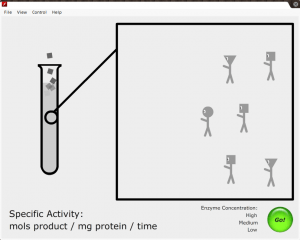This post is a follow-up to Introducing Video Workshops and will be continued with future examples.
I work with faculty and their students to integrate media components into the learning experience. I’d like to share a few unique experiences that I have had with offering media instruction on campus, and hear some of yours as well!
This week, I wanted to talk about a neat example I ran into while developing ideas for an interactive simulation with a Biochemistry professor.
Example: Media as a process for shaping curriculum

A few years ago, I worked with a professor to plan an interactive media component to help students with the concepts of a chemistry lab that spanned several weeks and several experiments. The professor found that students were having a hard time figuring out which data to use in what way when they reached the final experiment.
When we broke down the components of the lab into an interactive presentation, we began by outlining the problem. We illustrated the final experiment in the series, and explained how some of its resulting data came in the form of color measurements from a spectrophotometer. This highlighted the need for a set of correlation data that would tie specific spectrophotometer readings with specific quantities of an enzyme. With this understanding in place, we explained experiments that would provide each of the needed correlations to properly evaluate the main experiment.

Along the way, we came to an interesting realization: the steps for the lab did not align with the steps that we felt most clearly explained the design of the experiments. The lab procedure had the students perform the correlation experiments first to prevent bias, followed by the main experiment. But this left students without a concrete understanding of how their first 3 weeks of data would be useful until the final week of the lab. Ultimately, the professor changed the actual order of procedure in the lab to match the descriptive format of the review materials.
Now, I’m not going to suggest that revising course structure to suit a media narrative is always the best solution, but in this case, it was a neat find, and the concepts for the lab no longer seem to be a problem for students. Has anyone else had similar results?
I will be sharing additional examples over the next month or so–stay tuned!